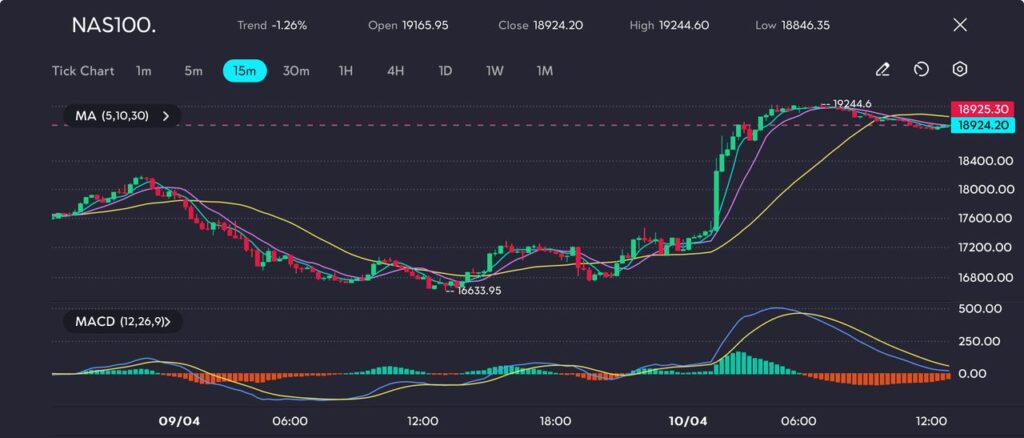
Key Points
- NASDAQ 100 falls 1.26%, closing at 18,924.20 after hitting an intraday high of 19,244.60.
- Trump announces 90-day tariff pause, but retains 125% tariffs on Chinese goods and a 10% blanket tariff globally.
- Bond yields ease from crisis levels; 10-year Treasury retreats to 4.2774% from a 4.5150% high.
Markets rallied sharply overnight, but the NASDAQ 100 failed to hold gains on Thursday, giving up early momentum to close down 1.26% at 18,924.20, even after hitting a high of 19,244.60 in the morning.
While Asian and European indices surged, sentiment in U.S. tech stocks deteriorated during the session as traders digested a temporary tariff pause from President Donald Trump, casting doubt on its scope and sustainability.
White House Flip-Flop Fuels Uncertainty
Trump’s abrupt decision to pause most new tariffs for 90 days initially sparked a global relief rally. However, tariffs on Chinese goods were raised to 125%, and a 10% blanket tariff on all other imports remains, limiting the impact. Traders, particularly in U.S. futures, quickly shifted their view as doubts over policy coherence and leadership credibility returned to the forefront.
As Westpac’s Martin Whetton put it, markets are “looking on with horror” as the administration oscillates between major policy reversals and distractions, such as executive orders on water pressure, during a period of extreme market stress.
While Japan’s Nikkei surged 8%, and EU futures jumped over 8%, U.S. tech stocks appear unconvinced. The “sell America” trade is heating up, with foreign exchange flows favouring the yen, Swiss franc, and gold, rather than the dollar or U.S. equity benchmarks.
Bond Market Shows Signs of Stabilisation
After days of carnage in the Treasury market, the 10-year yield eased to 4.2774%, down from Wednesday’s peak of 4.5150%, which had reignited fears of a 2020-style “dash for cash.” Still, structural worries persist. Analysts at LPL Financial cited sticky inflation, reduced foreign demand, hedge fund deleveraging, and illiquidity as core risks to bond market stability.
Fed minutes released Wednesday revealed that policymakers are deeply concerned about inflation, with little appetite for immediate cuts. Markets now price in 80 basis points of easing by year-end, down from 100 bps earlier in the week.
Technical Analysis
The NAS100 shows a significant reversal from the 16633.95 low, forming a classic V-shaped recovery supported by strong bullish momentum. After a prolonged downtrend, the index bottomed out and began establishing higher highs and higher lows—a clear shift in structure. This rally was confirmed by a bullish MACD crossover well below the zero line, with expanding green histogram bars and diverging signal lines, indicating strengthening momentum. The 5, 10, and 30-period moving averages all realigned into a bullish stack, further validating the uptrend.

Picture: Buyers dominate the second leg as resistance at 19244.6 briefly caps the move, as seen on the VT Markets app
Price action broke through multiple resistance levels, most notably surging past the psychological 18000 level and peaking around 19244.60. This area is now acting as near-term resistance, with price entering a sideways consolidation just below it. Despite the minor pullback, the trend remains structurally bullish as long as price holds above key support around 18600–18800. If momentum resumes, a breakout beyond 19250 could open the path toward retesting previous highs. The technical posture remains constructive, but momentum traders should watch for a MACD rollover or breakdown of the MA stack as potential signals of exhaustion.
Cautious Forecast
The NASDAQ 100’s failure to hold onto gains, despite an extraordinary global bounce, reflects a growing disconnect between policy relief headlines and trader confidence. With tariffs on China climbing and the Fed committed to holding rates, tech stocks face margin pressure and volatility ahead.
Until clarity emerges on trade negotiations, and unless Friday’s CPI and PPI data surprise to the downside, expect further chop in NASDAQ futures, with 18,500 acting as the next key support. A breakdown below could retest the 16,600 zone. Resistance remains firm at 19,250.









